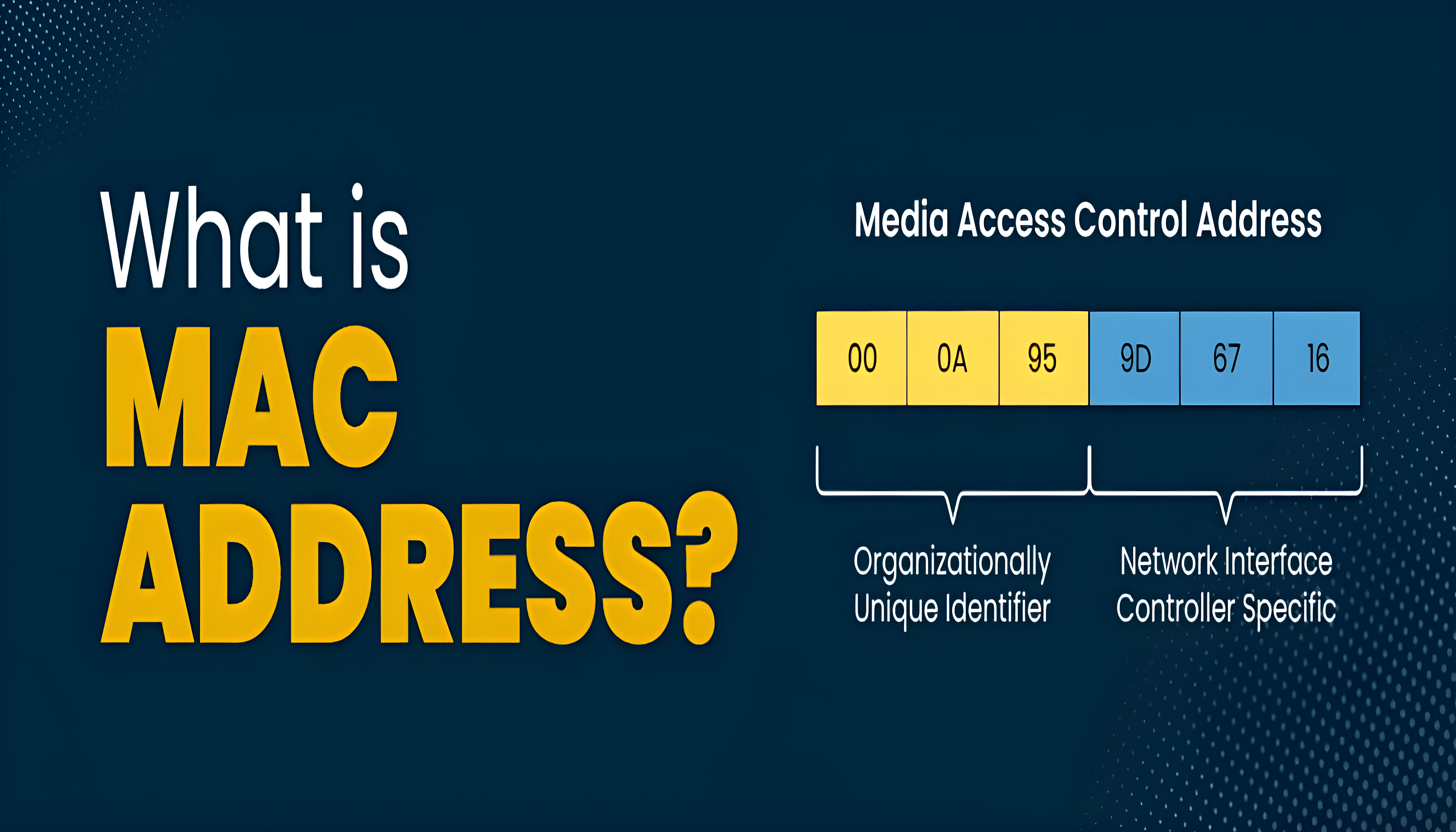An Overview of MAC Address:
A MAC address (Media Access Control) is a unique identifier assigned to the network interface card (NIC) of a device. It helps distinguish one device from another on a local network.Network communication is essential, especially when multiple devices connect to the same network, such as Wi-Fi networks, Ethernet connections, or Bluetooth devices.
MAC addresses are primarily assigned by device manufacturers, and are therefore often referred to as the burned-in address, or as an Ethernet hardware address, hardware address, or physical address.
Key Points About MAC Addresses
- Format:
- The length of a hexadecimal string is typically 48 bits (6 bytes), representing six pairs of hexadecimal numbers, like 00:1A:2B:3C:4D:5E. People often show it with colons (:) or hyphens (-) separating the byte pairs.
- The first 24 bits (first half) of the MAC address represent the Organizationally Unique Identifier (OUI), which identifies the manufacturer of the device. The remaining 24 bits are unique to each device produced by that manufacturer.
- Permanence:
- It usually burned into the network hardware, meaning each device has a unique MAC address that generally doesn’t change.
- However, some devices (like smartphones) allow for randomizing the MAC address as a privacy measure to prevent tracking when connecting to different Wi-Fi networks.
- Purpose:
- It operate at the data link layer (Layer 2) of the OSI model and are essential for device identification on a local network. They enable devices within the same network segment to find and communicate with each other directly.
- Unlike IP addresses, which can change depending on the network, a MAC address is static for each hardware interface.
- Usage:
- When a device joins a local network, its MAC address is used to direct packets within the network. For example, on an Ethernet network, MAC addresses enable switches to send data packets to the correct recipient on the same network.
- Network administrators may use MAC addresses for security (such as MAC address filtering), assigning specific devices access to the network based on their MAC addresses.
- Example of Applications:
- MAC Address Filtering: Routers can be configured to allow or block access to devices based on their MAC addresses.
- ARP Protocol: The Address Resolution Protocol (ARP) maps IP addresses to MAC addresses to enable communication within a network.
- Network Management: It useful for tracking and managing devices within a network for troubleshooting or auditing purposes.
Here’s a deeper dive into MAC addresses:
1. Structure of a MAC Address
It consists of 48 bits (6 bytes) and is written in hexadecimal notation. It’s divided into two main parts:
- Organizationally Unique Identifier (OUI): The first 24 bits (3 bytes) represent the manufacturer or vendor of the network interface. Each manufacturer is assigned a specific range of addresses by the IEEE (Institute of Electrical and Electronics Engineers).
- Device Identifier: The manufacturer uses the remaining 24 bits (3 bytes) to uniquely identify the specific network interface card (NIC). This ensures that every device produced has a unique MAC address.
Example : 00:1A:2B:3C:4D:5E
00:1A:2Bis the OUI, representing the manufacturer.3C:4D:5Eis the unique device identifier assigned by the manufacturer.
2. How it Work in Networking
When devices communicate within a local network (e.g., within your home Wi-Fi network or corporate LAN), they play a key role in ensuring that the right recipient receives the data. Here’s how it works:
- Address Resolution Protocol (ARP): When a device wants to send data to another device within the same network, it uses ARP to map an IP address to the corresponding MAC address. This is necessary because users utilize it for communication within the network, while they use IP addresses for communication over the internet.
- Data Transmission: Once it is determined, the data packets are encapsulated with the recipient’s address and sent over the network. Switches and routers use it to ensure that the packets reach the correct device.
3. MAC Address Spoofing
Although it is hardcoded into a device’s hardware, software manipulation can change or “spoof” it. This can be done for various reasons:
- Privacy: Some users spoof their address to prevent tracking on public Wi-Fi networks.
- Bypass Network Restrictions: In networks that control access through MAC filtering by allowing only devices with approved addresses, a user might spoof their address to bypass these restrictions.
However, attackers can use spoofing for malicious purposes, such as gaining unauthorized access to a network or impersonating another device.
4. MAC Address Filtering for Security
Many routers offer this filtering as a security feature. This allows network administrators to specify which devices can connect to the network based on their MAC addresses. If a device’s address is not on the approved list, it won’t be allowed to connect.
While this adds a layer of security, it’s not foolproof since, as mentioned earlier, It can be spoofed.
5. Dynamic vs. Static MAC Addresses
- Static MAC Address: This is the default configuration where a device’s MAC address remains unchanged and tied to its hardware.
- Dynamic MAC Address: In some network setups, virtual machines (VMs) or cloud environments may assign dynamic MAC addresses, which can change when the VM or instance is restarted.
6. MAC Address and Network Performance
This themselves don’t directly affect performance, but they play a crucial role in efficient network communication. For example:
- Network Switches: Switches use this to create a MAC address table, which helps them direct data packets only to the relevant device. This minimizes unnecessary network traffic and enhances performance.
- Load Balancing: In some enterprise environments, load-balancing algorithms can use this to distribute network traffic evenly across devices.
Applications:
They have several practical applications in network management, security, and device communication. Here’s a look at the key applications:
1. Device Identification on a Network
- Unique Identifier: Each device’s MAC address serves as a unique identifier on a local network, enabling the recognition of devices like computers, smartphones, and printers individually.
- Network Traffic Routing: Switches and routers use MAC addresses to direct packets to the appropriate devices within the local network, ensuring data reaches the intended recipient.
2. Access Control and Network Security
- MAC Address Filtering: Network administrators can set up routers or access points to only allow devices with specific MAC addresses to connect to the network, providing an extra layer of security.
- Device Whitelisting and Blacklisting: Administrators can track MAC addresses to create whitelists or blacklists for devices, controlling which ones are allowed or denied access.
- Intrusion Detection: Security systems monitor MAC addresses to identify unauthorized devices, helping to detect potential intrusions or rogue devices on a network.
3. Network Access Management and Monitoring
- DHCP Address Assignment: The Dynamic Host Configuration Protocol (DHCP) uses MAC addresses to assign IP addresses to devices on a network. This mapping allows devices to retain the same IP address on a specific network.
- Bandwidth Management: Network administrators can monitor and manage bandwidth usage by tracking MAC addresses. This helps to identify high-bandwidth users and allocate resources accordingly.
- Usage Tracking: By tracking devices’ MAC addresses, network administrators can keep a log of connected devices and monitor network activity for troubleshooting or auditing purposes.
4. Troubleshooting and Diagnostics
- Device Location in Large Networks: It help administrators locate specific devices within a network. For example, in large organizations, It help pinpoint issues related to connectivity or network performance for individual devices.
- Network Mapping: Network management tools use MAC addresses to map and visualize devices within a network, helping administrators understand device connections and detect network configuration errors.
5. ARP and Network Layer Protocols
- Address Resolution Protocol (ARP): ARP maps IP addresses to MAC addresses, allowing devices to communicate over the network. This protocol is essential for local network communication, as it helps determine which MAC address corresponds to a given IP address.
- MAC-to-IP Mapping: Many network protocols and applications rely on the MAC-to-IP address mapping to enable efficient communication within the network.
6. User Authentication
- Device-Based Authentication: Some systems, such as corporate networks and campus Wi-Fi, use MAC addresses to authenticate devices without requiring login credentials. This allows users who have registered devices to connect more easily.
- Access Control Systems: In environments where security is critical, administrators can set up systems to allow only authorized devices with known MAC addresses to access resources or data.
7. IoT (Internet of Things) Device Management
- Smart Device Identification: Many IoT devices, such as smart home systems, use MAC addresses to identify each device on the network and allow them to interact with each other and the central hub.
- Device Tracking in Large IoT Networks: In industrial or commercial IoT setups, MAC addresses help track devices, making it easier to manage a large number of connected devices.
8. Location Tracking and Analytics
- Indoor Positioning: In settings like malls or airports, businesses can use the MAC addresses of Wi-Fi-enabled devices (anonymously and with user consent) to track movement patterns and offer insights into customer behavior.
- Retail Analytics: Stores can use MAC address data from devices to study foot traffic patterns, the effectiveness of displays, and customer engagement. For privacy, many systems use anonymized or randomized MAC addresses.
9. Personal Device Privacy and Security
- MAC Address Randomization: To protect user privacy, modern devices allow MAC address randomization, particularly when scanning for Wi-Fi networks. This helps prevent tracking based on MAC addresses in public locations.
10. Telecommunications and ISP Management
- Cable Modem Authentication: Internet Service Providers (ISPs) use MAC addresses to authenticate cable modems or routers, ensuring only registered devices can connect to the network.
- Network Bandwidth Allocation: ISPs may track MAC addresses to monitor user activity and apply bandwidth limits based on the device’s network usage profile.
11. Digital Forensics
- Forensic Analysis: It play a role in digital forensics, helping investigators trace the source or movement of data and identify devices that accessed or transmitted specific information.
- Network Incident Investigation: In the event of a network security incident, the MAC addresses of connected devices can help trace the activity back to specific devices and users.
It play an essential role in network management, security, and device authentication. While they’re primarily a local identifier, they’re crucial for ensuring secure and efficient communication across networks.
𝕋𝕙𝕒𝕟𝕜 𝕐𝕠𝕦 𝔽𝕠𝕣 𝕍𝕚𝕤𝕚𝕥𝕚𝕟𝕘 𝕆𝕦𝕣 𝕎𝕖𝕓𝕤𝕚𝕥𝕖𝕤 🙂

